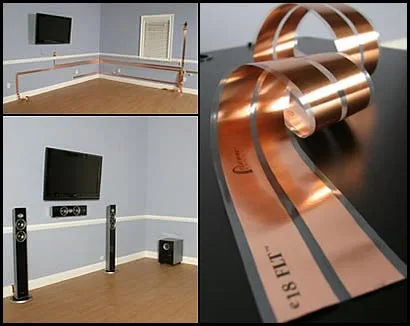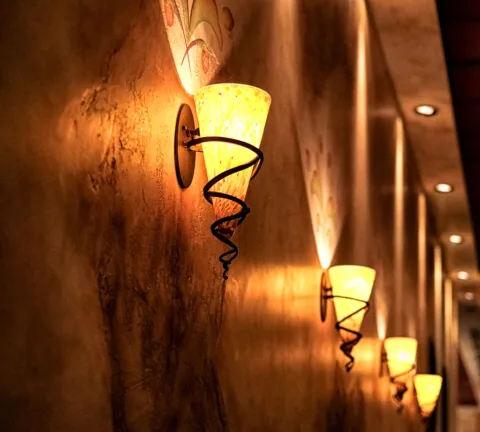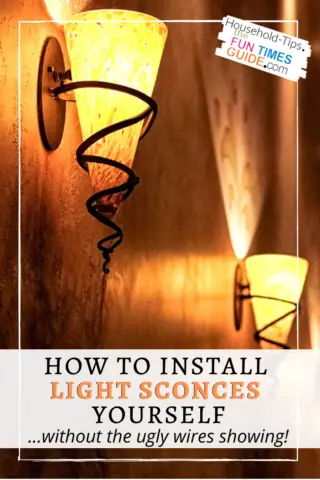I saw this really cool product on television the other day. It was one of the Top 18 Products – Popular Mechanic’s Editor Choice Awards at the Consumer Electronics Show (CES) in Las Vegas.
It’s a product called FlatWire (similar to Ghost Wire and TaperWire).
I could’ve used this product a few years ago, as a solution to put a pair of light sconces on our wall without the typical DIYer’s “hide the wire encased in a decorative metal bar that extends vertically down the wall” solution.
I thought I should take a look at this product to see if it’s too good to be true or not. Flatwire has been out for a couple of years and they’ve added to their product line.
Too good to be true? Hmmm… that depends on your level of skill when it comes to mudding, sanding, and painting. It’s also a little more expensive than premium wire. Don’t get me wrong. This is a very cool invention — but is it worth the price and “minimal” effort to get a pair of light sconces on your wall without the ugly wiring needed to power them?
Let’s find out…
Robert Sexton is the inventor and founder of FlatWire.
It was one of those “necessity is the mother of invention” moments that struck him on a home project one day as he was pondering the question,”Why is wire round? Why can’t it be flat?”
He investigated further and found out that wire is round mainly because of construction and manufacturing techniques — and that physics has nothing to do with it.
That was about 20 years ago and now he’s beginning to see the fruits of his labor.
FlatWire is manufactured by SouthWire, one of the largest wire manufacturers in the world. Apparently, they feel that FlatWire is worthy of their attention and marketing dollars. SouthWire is a very respectable company — so that says a lot about FlatWire.
This stuff is very thin and flexible:
- It’s thinner than a credit card at 0.009″ thin and 2.274″ wide.
- It’s rated at 18e AWG.
- You use their (paintable) connection boxes on both ends to hook up your sconces and to plug them into a standard electrical socket at the other end of it.
How Much Will It Cost To Buy Everything Needed To Have My Sconces Up on the Wall?
FlatWire (in this application) is a UL Listed Class 2, Low Voltage wire. You must buy FlatWire’s low voltage light sconces to make this set-up work. Each sconce uses a standard 20W halogen bulb. FlatWire will not work with a standard light sconce that you’ve been eyeing down at the antique store.
So what should you do? You have 3 choices:
- Buy the super cool FlatWire sconce kit and do it up.
- Buy the sconces of your dreams, cut a couple holes in the wall to fish the wire through and then patch it.
- Do neither. Instead, buy a pair of candle-powered sconces. (That’s what we did in one location of our home.)
If you’ve decided to make the FlatWire purchase, then read on…
Depending on the finish, the complete FlatWire sconce kit costs $199 to $249, plus your cost for joint compound and paint. (The kit also comes with a DVD for DIYers.)
Here’s what you will need to do once you have the FlatWire kit in hand:
- Decide where your sconces will be placed.
- Map out where the FlatWire will go on the wall.
- Prime the walls.
- Spray the adhesive on the wall along the wiring path.
- Apply the FlatWire along the adhesive “path”.
- Apply the mesh tape on the FlatWire.
- Apply your joint compound and smooth it out.
- Sand it. (Re-mud if necessary — and re-sand.)
- Paint it.
Now compare all of that with buying a pair of comparable light sconces ($40 to $75), paint (leftover… practically free), a drywall patch repair kit ($6), standard wire ($15), plus your time and labor.
There are 2 main considerations:
- Total cost
- Your DIY skill level in 2 arenas: electrical (to hard-wire the standard sconces) and drywalling
You decide. Either way, it’s a decent amount of work to go through to retrofit a pair of sconces to have that builder-installed look.
For now, I’m sticking with my candle sconces.
Here’s another way to install light sconces yourself without the wires showing:
UPDATE
Flatwire has also branched out into A/V cable, data cable and HDMI cable.
Must read: How to run A/V cable through your home — a great DIY project.
Like this post? Save it to read again later… or share with others on Pinterest!






